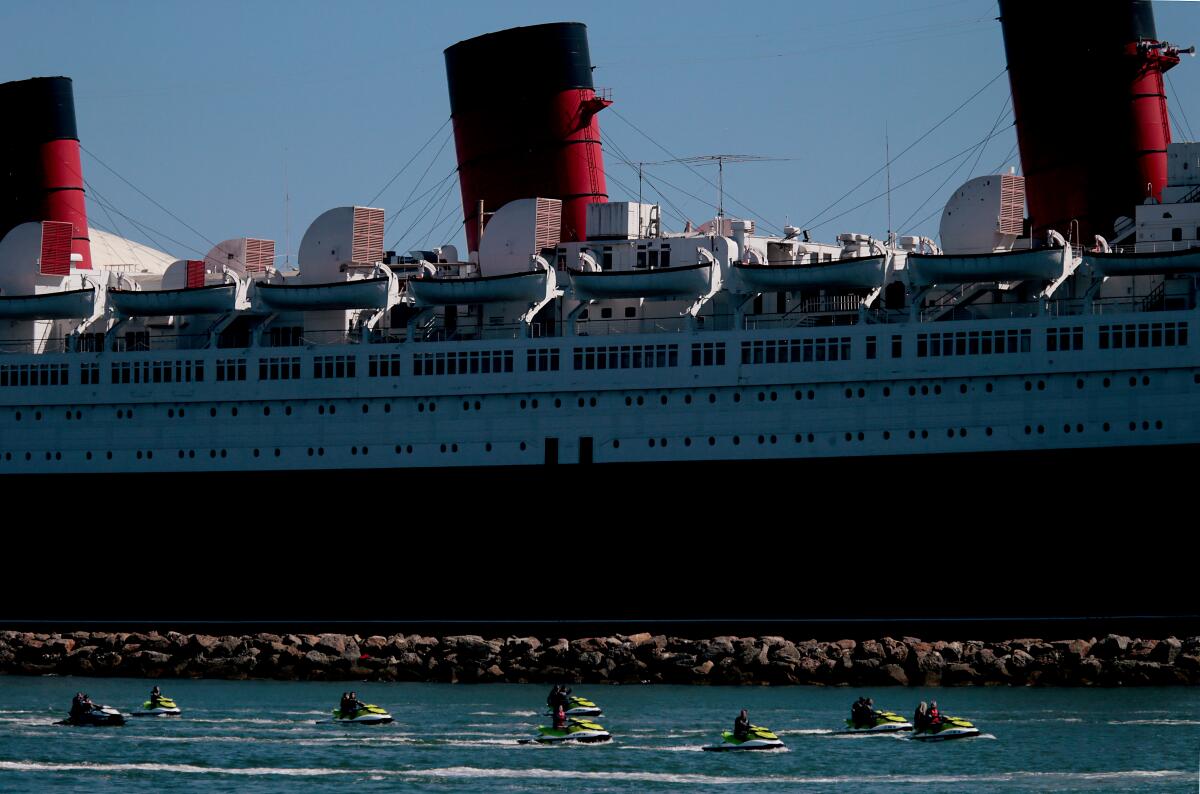Long Beach fails to keep Queen Mary lifeboats afloat

- Share via
The city of Long Beach plans to dispose of 19 lifeboats from the Queen Mary after a bidding process to identify preservationists and historical groups to restore them failed.
A structural study of the 86-year-old ocean liner determined that the lifeboats were putting too much strain on the frame of the ship, prompting the city to seek bidders willing to save the lifeboats from ending up in landfills or scrap yards.
But the bidding process, which ended April 28, concluded with only two bidders, Long Beach officials said. One bidder withdrew and the other failed to submit the documentation required by the city, the officials said.
“The city considers the matter closed and will move forward with the safe disassembly of the remaining lifeboats, per applicable health, safety and environmental regulations, and will work to identify potential creative solutions to repurpose elements of the lifeboats,” Joy Contreras, a spokesperson for the Long Beach Public Works Department, said in a statement Wednesday.
The effort to save the lifeboats is the latest chapter in the Queen Mary’s 55-year history in Long Beach, where the 1,019-foot-long ship has been docked, drawing 1.6 million visitors a year before it closed in 2020 because of the pandemic.
The ship has also been the subject of numerous disputes among city officials and preservationists over how to repair and restore it, and how much to spend to save a vessel seen as a part of local history.
In the bidding process for the lifeboats, bidders were not required to put up any money but had to prove to the city that they had the finances and ability to transport and restore the lifeboats.
Mary Rohrer, executive director of QMI Restore the Queen, a nonprofit that is dedicated to raising money to restore the ship, said her group withdrew from the bidding process because it was not willing to sign a liability waiver to clean and dispose of hazardous materials on the lifeboats, including lead paint.
“Lead paint is a huge issue,” she said.
The second bidder, Zack Armstrong of Shadow Hills, could not be reached for comment.
The city required that the bidders interested in preserving the remaining boats show they have the financial means to transport the boats from the ship, restore them and sign a waiver, releasing the city from liability for the lead-based paint on the boats.
One of the lifeboats is 30 feet long; the rest are 36 feet long and weigh about 12,000 pounds.
Long Beach opened the bidding process Feb. 17 and initially gave potential bidders until March 25 to submit offers. At the behest of Rohrer and others, the city agreed to extend the bidding process until April 28 to increase the chances of identifying bidders for all the lifeboats.
Long Beach — which has owned the Queen Mary since it sailed into the harbor in 1967 — took control of the ship in June after the company that previously held the lease to operate it, Eagle Hospitality Trust, filed for bankruptcy protection in January and agreed to surrender its lease agreement.
Several concessionaires have operated and maintained the ship as a floating hotel and tourist attraction over the last five decades, with mixed results. A 2017 study said as much as $289 million worth of renovations and upgrades were needed to keep parts of the ship from flooding. Since taking over the ship, the city has allocated $5.5 million to make the repairs needed to reopen it to the public.
A study found that the 22 lifeboats hanging from davits on the deck needed to be removed. The city plans to keep at least two of the original lifeboats on the ship and one to exhibit on the ground near the ship.
Rohrer said her group has suggested that the city allow it to remove and sell the metal fittings and other historically significant items from the lifeboats to raise money for the preservation of the three lifeboats that will be spared.
More to Read
Inside the business of entertainment
The Wide Shot brings you news, analysis and insights on everything from streaming wars to production — and what it all means for the future.
You may occasionally receive promotional content from the Los Angeles Times.











